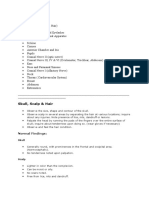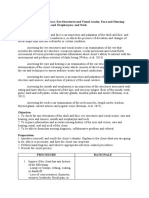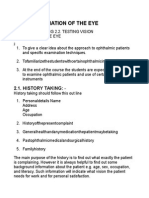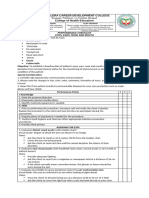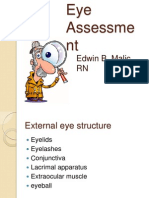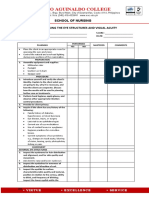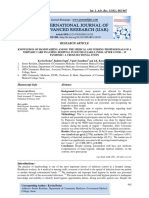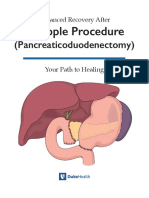Skull, Scalp & Hair: Physical Assessment Is An
Skull, Scalp & Hair: Physical Assessment Is An
Uploaded by
Trixie Al MarieCopyright:
Available Formats
Skull, Scalp & Hair: Physical Assessment Is An
Skull, Scalp & Hair: Physical Assessment Is An
Uploaded by
Trixie Al MarieOriginal Description:
Original Title
Copyright
Available Formats
Share this document
Did you find this document useful?
Is this content inappropriate?
Copyright:
Available Formats
Skull, Scalp & Hair: Physical Assessment Is An
Skull, Scalp & Hair: Physical Assessment Is An
Uploaded by
Trixie Al MarieCopyright:
Available Formats
Physical assessment is an inevitable procedure not just for nurses but also doctors.
Establishing a good assessment would later-on provide a more accurate diagnosis, planning and better interventions and evaluation, thats why its important to have good and strong assessment is. Below is your ultimate guide in performing a physical assessment. You might want to print a copy and bring it during your hospital duty, making your physical assessment better and more accurate!
Skull, Scalp & Hair
Observe the size, shape and contour of the skull. Observe scalp in several areas by separating the hair at various locations; inquire about any injuries. Note presence of lice, nits, dandruff or lesions. Palpate the head by running the pads of the fingers over the entire surface of skull; inquire about tenderness upon doing so. (wear gloves if necessary) Observe and feel the hair condition. Normal Findings:
Skull
Generally round, with prominences in the frontal and occipital area. (Normocephalic). No tenderness noted upon palpation.
Scalp
Lighter in color than the complexion. Can be moist or oily. No scars noted. Free from lice, nits and dandruff. No lesions should be noted. No tenderness or masses on palpation.
Hair
Can be black, brown or burgundy depending on the race.
Alopecia
Evenly distributed covers the whole scalp No evidences of Alopecia Maybe thick or thin, coarse or smooth. Neither brittle nor dry.
Face
Observe the face for shape. Inspect for Symmetry. Inspect for the palpebral fissure (distance between the eye lids); should be equal in both eyes. Ask the patient to smile, There should be bilateral Nasolabial fold (creases extending from the angle of the corner of the mouth). Slight asymmetry in the fold is normal. If both are met, then the Face is symmetrical Test the functioning of Cranial Nerves that innervates the facial structures
CN V (Trigeminal)
1. Sensory Function Ask the client to close the eyes. Run cotton wisp over the fore head, check and jaw on both sides of the face. Ask the client if he/she feel it, and where she feels it. Check for corneal reflex using cotton wisp. The normal response in blinking. 2. Motor function Ask the client to chew or clench the jaw. The client should be able to clench or chew with strength and force.
CN VII (Facial)
1. Sensory function (This nerve innervate the anterior 2/3 of the tongue). Place a sweet, sour, salty, or bitter substance near the tip of the tongue. Normally, the client can identify the taste. 2. Motor function Ask the client to smile, frown, raise eye brow, close eye lids, whistle, or puff the cheeks. Normal Findings Shape maybe oval or rounded. Face is symmetrical. No involuntary muscle movements. Can move facial muscles at will. Intact cranial nerve V and VII.
Eyebrows, Eyes and Eyelashes
All three structures are assessed using the modality of inspection. Normal findings
Eyebrows
Symmetrical and in line with each other.
Maybe black, brown or blond depending on race. Evenly distributed.
Eyes
Evenly placed and inline with each other. None protruding. Equal palpebral fissure.
Eyelashes
Color dependent on race. Evenly distributed. Turned outward.
Eyelids and Lacrimal Apparatus
Inspect the eyelids for position and symmetry. Palpate the eyelids for the lacrimal glands. To examine the lacrimal gland, the examiner, lightly slide the pad of the index finger against the clients upper orbital rim. Inquire for any pain or tenderness. Palpate for the nasolacrimal duct to check for obstruction. To assess the nasolacrimal duct, the examiner presses with the index finger against the clients lower inner orbital rim, at the lacrimal sac, NOT AGAINST THE NOSE. In the presence of blockage, this will cause regurgitation of fluid in the puncta Normal Findings
Eyelids
Upper eyelids cover the small portion of the iris, cornea, and sclera when eyes are open. No PTOSIS noted. (Drooping of upper eyelids). Meets completely when eyes are closed. Symmetrical.
Lacrimal Apparatus
Lacrimal gland is normally non palpable. No tenderness on palpation. No regurgitation from the nasolacrimal duct.
Conjunctivae
The bulbar and palpebral conjunctivae are examined by separating the eyelids widely and having the client look up, down and to each side. When separating the lids, the examiner should exert NO PRESSURE against the eyeball; rather, the examiner should hold the lids against the ridges of the
bony orbit surrounding the eye. In examining the palpebral conjunctiva, everting the upper eyelid in necessary and is done as follow: 1. Ask the client to look down but keep his eyes slightly open. This relaxes the levator muscles, whereas closing the eyes contracts the orbicularis muscle, preventing lid eversion. 2. Gently grasp the upper eyelashes and pull gently downward. Do not pull the lashes outward or upward; this, too, causes muscles contraction. 3. Place a cotton tip application about I can above the lid margin and push gently downward with the applicator while still holding the lashes. This everts the lid. 4. Hold the lashes of the everted lid against the upper ridge of the bony orbit, just beneath the eyebrow, never pushing against the eyebrow. 5. Examine the lid for swelling, infection, and presence of foreign objects. 6. To return the lid to its normal position, move the lid slightly forward and ask the client to look up and to blink. The lid returns easily to its normal position. Normal Findings: Both conjunctivae are pinkish or red in color. With presence of many minutes capillaries. Moist No ulcers No foreign objects
Sclerae
The sclerae is easily inspected during the assessment of the conjunctivae. Normal Findings Sclerae is white in color (anicteric sclera) No yellowish discoloration (icteric sclera). Some capillaries maybe visible. Some people may have pigmented positions.
Cornea
The cornea is best inspected by directing penlight obliquely from several positions. Normal findings There should be no irregularities on the surface. Looks smooth. The cornea is clear or transparent. The features of the iris should be fully visible through the cornea. There is a positive corneal reflex.
Anterior Chamber and Iris
The anterior chamber and the iris are easily inspected in conjunction with the cornea. The technique of oblique illumination is also useful in assessing the anterior chamber. Normal Findings: The anterior chamber is transparent. No noted any visible materials. Color of the iris depends on the persons race (black, blue, brown or green). From the side view, the iris should appear flat and should not be bulging forward. There should be NO crescent shadow casted on the other side when illuminated from one side.
Pupils
Examination of the pupils involves several inspections, including assessment of the size, shape reaction to light is directed is observed for direct response of constriction. Simultaneously, the other eye is observed for consensual response of constriction. The test for papillary accommodation is the examination for the change in papillary size as it is switched from a distant to a near object. Ask the client to stare at the objects across room. Then ask the client to fix his gaze on the examiners index fingers, which is placed 5 5 inches from the clients nose. Visualization of distant objects normally causes papillary dilation and visualization of nearer objects causes papillary constriction and convergence of the eye. Normal Findings Pupillary size ranges from 3 7 mm, and are equal in size. Equally round. Constrict briskly/sluggishly when light is directed to the eye, both directly and consensual. Pupils dilate when looking at distant objects, and constrict when looking at nearer objects. If all of which are met, we document the findings using the notation PERRLA, pupils equally round, reactive to light, and accommodate
Cranial Nerve II (optic nerve)
The optic nerve is assessed by testing for visual acuity and peripheral vision. Visual acuity is tested using a snellen chart, for those who are illiterate and unfamiliar with the western alphabet, the illiterate E chart, in which the letter E faces in different directions, maybe used. The chart has a standardized number at the end of each
line of letters; these numbers indicates the degree of visual acuity when measured at a distance of 20 feet. The numerator 20 is the distance in feet between the chart and the client, or the standard testing distance. The denominator 20 is the distance from which the normal eye can read the lettering, which correspond to the number at the end of each letter line; therefore the larger the denominator the poorer the version. Measurement of 20/20 vision is an indication of either refractive error or some other optic disorder. In testing for visual acuity you may refer to the following: The room used for this test should be well lighted. A person who wears corrective lenses should be tested with and without them to check fro the adequacy of correction. Only one eye should be tested at a time; the other eye should be covered by an opaque card or eye cover, not with clients finger. Make the client read the chart by pointing at a letter randomly at each line; maybe started from largest to smallest or vice versa. A person who can read the largest letter on the chart (20/200) should be checked if they can perceive hand movement about 12 inches from their eyes, or if they can perceive the light of the penlight directed to their yes.
Peripheral Vision or visual fields
The assessment of visual acuity is indicative of the functioning of the macular area, the area of central vision. However, it does not test the sensitivity of the other areas of the retina which perceive the more peripheral stimuli. The Visual field confrontation test, provide a rather gross measurement of peripheral vision. The performance of this test assumes that the examiner has normal visual fields, since that clients visual fields are to be compared with the examiners. Follow the steps on conducting the test: The examiner and the client sit or stand opposite each other, with the eyes at the same, horizontal level with the distance of 1.5 2 feet apart. The client covers the eye with opaque card, and the examiner covers the eye that is opposite to the client covered eye. Instruct the client to stare directly at the examiners eye, while the examiner stares at the clients open eye. Neither looks out at the object approaching from the periphery. The examiner hold an object such as pencil or penlight, in his hand and
gradually moves it in from the periphery of both directions horizontally and from above and below. Normally the client should see the same time the examiners sees it. The normal visual field is 180 degrees.
Cranial Nerve III, IV & VI (Oculomotor, Trochlear, Abducens)
All the 3 Cranial nerves are tested at the same time by assessing the Extra Ocular Movement (EOM) or the six cardinal position of gaze. Follow the given steps: Stand directly in front of the client and hold a finger or a penlight about 1 ft from the clients eyes. Instruct the client to follow the direction the object hold by the examiner by eye movements only; that is with out moving the neck. The nurse moves the object in a clockwise direction hexagonally. Instruct the client to fix his gaze momentarily on the extreme position in each of the six cardinal gazes. The examiner should watch for any jerky movements of the eye (nystagmus). Normally the client can hold the position and there should be no nystagmus.
Ears
Inspect the auricles of the ears for parallelism, size position, appearance and skin color. Palpate the auricles and the mastoid process for firmness of the cartilage of the auricles, tenderness when manipulating the auricles and the mastoid process. Inspect the auditory meatus or the ear canal for color, presence of cerumen, discharges, and foreign bodies. For adult pull the pinna upward and backward to straiten the canal. For children pull the pinna downward and backward to straiten the canal Perform otoscopic examination of the tympanic membrane, noting the color and landmarks. Normal Findings The ear lobes are bean shaped, parallel, and symmetrical. The upper connection of the ear lobe is parallel with the outer canthus of the eye. Skin is same in color as in the complexion. No lesions noted on inspection. The auricles are has a firm cartilage on palpation. The pinna recoils when folded. There is no pain or tenderness on the palpation of the auricles and mastoid process. The ear canal has normally some cerumen of inspection.
No discharges or lesions noted at the ear canal. On otoscopic examination the tympanic membrane appears flat, translucent and pearly gray in color.
Nose and Paranasal Sinuses
The external portion of the nose is inspected for the following: Placement and symmetry. Patency of nares (done by occluding nosetril one at a time, and noting for difficulty in breathing) Flaring of alae nasi Discharge The external nares are palpated for: Displacement of bone and cartilage. For tenderness and masses The internal nares are inspected by hyper extending the neck of the client, the ulnar aspect of the examiners hard over the fore head of the client, and using the thumb to push the tip of the nose upward while shining a light into the nares. Inspect for the following: Position of the septum. Check septum for perforation. (Can also be checked by directing the lighted penlight on the side of the nose, illumination at the other side suggests perforation). The nasal mucosa (turbinates) for swelling, exudates and change in color.
Paranasal Sinuses
Examination of the paranasal sinuses is indirectly. Information about their condition is gained by inspection and palpation of the overlying tissues. Only frontal and maxillary sinuses are accessible for examination. By palpating both cheeks simultaneously, one can determine tenderness of the maxillary sinusitis, and pressing the thumb just below the eyebrows, we can determine tenderness of the frontal sinuses.
Normal Findings
Nose in the midline No Discharges. No flaring alae nasi. Both nares are patent. No bone and cartilage deviation noted on palpation. No tenderness noted on palpation. Nasal septum in the mid line and not perforated. The nasal mucosa is pinkish to red in color. (Increased redness turbinates are typical of allergy). No tenderness noted on palpation of the paranasal sinuses.
Cranial Nerve I (Olfactory Nerve)
To test the adequacy of function of the olfactory nerve: The client is asked to close his eyes and occlude. The examiner places aromatic and easily distinguish nose. (E.g. alcohol, vinegar, coffee). Ask the client to identify the odor. Each side is tested separately, ideally with two different substances.
Mouth and Oropharynx Lips
Inspected for: Symmetry and surface abnormalities. Color Edema Normal Findings: With visible margin Symmetrical in appearance and movement Pinkish in color No edema
Temporomandibular
Palpate while the mouth is opened wide and then closed for: Crepitus Deviations Tenderness Normal Findings: Moves smoothly no crepitous. No deviations noted No pain or tenderness on palpation and jaw movement.
Gums
Inspected for: Color Bleeding Retraction of gums. Normal Findings: Pinkish in color No gum bleeding No receding gums
Teeth
Inspected for: Number Color
Dental carries Dental fillings Alignment and malocclusions (2 teeth in the space for 1, or overlapping teeth). Tooth loss Breath should also be assessed during the process. Normal Findings 28 for children and 32 for adults. White to yellowish in color With or without dental carries and/or dental fillings. With or without malocclusions. No halitosis.
Tongue
Palpated for: Texture Normal Findings: Pinkish with white taste buds on the surface. No lesions noted. No varicosities on ventral surface. Frenulum is thin attaches to the posterior 1/3 of the ventral aspect of the tongue. Gag reflex is present. Able to move the tongue freely and with strength. Surface of the tongue is rough.
Uvula
Inspected for: Position Color Cranial Nerve X (Vagus nerve) Tested by asking the client to say Ah note that the uvula will move upward and forward. Normal Findings: Positioned in the mid line. Pinkish to red in color. No swelling or lesion noted. Moves upward and backwards when asked to say ah
Tonsils
Inspected for: Inflammation Size A Grading system used to describe the size of the tonsils can be used. Grade 1 Tonsils behind the pillar. Grade 2 Between pillar and uvula. Grade 3 Touching the uvula Grade 4 In the midline.
You might also like
- CS Form No. 212 Revised Personal Data SheetDocument5 pagesCS Form No. 212 Revised Personal Data SheetKim Rose Sabuclalao85% (13)
- Health Assessment ChecklistDocument10 pagesHealth Assessment ChecklistRuby Ann Narvasa100% (1)
- NCP For HemothoraxDocument12 pagesNCP For Hemothoraxroseonabreeze0% (1)
- Head To Toe AssessmentDocument18 pagesHead To Toe AssessmentCin Dy100% (2)
- Physical Assessment Guide of Head-To-ToeDocument9 pagesPhysical Assessment Guide of Head-To-Toeneleh gray100% (2)
- 8 Part Eye Exam RevisedDocument17 pages8 Part Eye Exam Revisedpasambalyrradjohndar100% (1)
- 08 INSARAG Patient Treatment Record PDFDocument1 page08 INSARAG Patient Treatment Record PDFluisacocaliNo ratings yet
- Head To Toe AssessmentDocument21 pagesHead To Toe AssessmentZahra jane A.100% (1)
- Ultimate Guide To HeadDocument29 pagesUltimate Guide To HeadCjoy Alonday100% (1)
- Physical Assessment (Normal Findings)Document31 pagesPhysical Assessment (Normal Findings)Rinki SinghNo ratings yet
- Head To Toe Physical AssessmentDocument27 pagesHead To Toe Physical AssessmentLarmay dcsn100% (1)
- Head-To-Toe Assessment A. Head (Skull, Scalp, Hair)Document35 pagesHead-To-Toe Assessment A. Head (Skull, Scalp, Hair)Kris_Hilyn_9815No ratings yet
- Head To Toe AssessmentDocument22 pagesHead To Toe AssessmentNessa Layos Morillo100% (1)
- Head To Toe Assessment ToolDocument19 pagesHead To Toe Assessment ToolJeah Mae CastroNo ratings yet
- Script On AssessmentDocument14 pagesScript On AssessmentissaiahnicolleNo ratings yet
- Assessment of EyeDocument34 pagesAssessment of Eyeraima ayazNo ratings yet
- Assessment of The EyesDocument32 pagesAssessment of The EyesArlyn Mendenilla100% (1)
- Assessing EyesDocument5 pagesAssessing EyesMercy Anne EcatNo ratings yet
- Head 2 ToeDocument40 pagesHead 2 Toeeza kemal firdausNo ratings yet
- Salcedo Ha Cu 7 Adult Assessment Eyes 24Document69 pagesSalcedo Ha Cu 7 Adult Assessment Eyes 24shaimonteverdeNo ratings yet
- Vision Procedure With EquipmentDocument5 pagesVision Procedure With EquipmentfileacademicsNo ratings yet
- Nursing case study formatDocument4 pagesNursing case study formatPreeths RoshanNo ratings yet
- Health Assessment 11Document10 pagesHealth Assessment 11shannon c. lewisNo ratings yet
- Anatomy of The Eye EYE: Extaocular StructuresDocument5 pagesAnatomy of The Eye EYE: Extaocular StructuresfLOR_ZIANE_MAENo ratings yet
- Head To Neck Health AssessmentDocument6 pagesHead To Neck Health AssessmentKathrina Doroneo (rina)No ratings yet
- Scalp: Normal Findings: SkullDocument13 pagesScalp: Normal Findings: SkullfranlynNo ratings yet
- EARSEYESDocument93 pagesEARSEYESZen Gesner Kenneth G. EganaNo ratings yet
- Head and Neck AssessmentDocument113 pagesHead and Neck AssessmenttdisnahNo ratings yet
- Eye Assessment: Physical Assessment Course/ TheoryDocument31 pagesEye Assessment: Physical Assessment Course/ Theoryroama3359No ratings yet
- Millimeter Ruler Penlight Eye Chart Opaque CardDocument13 pagesMillimeter Ruler Penlight Eye Chart Opaque CardemraduraiyenNo ratings yet
- 4. Eye Assessment Theory._5cd360ef964d58509d0422fcc29cdf1cDocument36 pages4. Eye Assessment Theory._5cd360ef964d58509d0422fcc29cdf1cagaloudhNo ratings yet
- 8 Part Eye Exam REVISED PDFDocument16 pages8 Part Eye Exam REVISED PDFJerwin EstacioNo ratings yet
- Examination of The Cranial Nerves: I OlfactoryDocument6 pagesExamination of The Cranial Nerves: I Olfactorygolagani praveenkumarNo ratings yet
- Assessing The Skull and Face Eye Structures and Visual Acuity Ears and Hearing Nose and Sinuses Mouth and Oropharynx and Neck Basic ConceptDocument23 pagesAssessing The Skull and Face Eye Structures and Visual Acuity Ears and Hearing Nose and Sinuses Mouth and Oropharynx and Neck Basic ConceptFrancar Jade De VeraNo ratings yet
- 06 EENT AssessmentDocument36 pages06 EENT AssessmentHerlinaNababanNo ratings yet
- OPTHALMOLOGY-1Document197 pagesOPTHALMOLOGY-1ndianguipauline3560No ratings yet
- Unit Two Basic Examination of The Eye: 2.1. History TakingDocument12 pagesUnit Two Basic Examination of The Eye: 2.1. History TakingiuytrerNo ratings yet
- HEENT Exam Teaching DocketDocument10 pagesHEENT Exam Teaching DocketJonah R. MeranoNo ratings yet
- 8 Part Eye Exam REVISEDDocument17 pages8 Part Eye Exam REVISEDfelisareyes28No ratings yet
- Assesing EyesDocument7 pagesAssesing EyesYudi TrigunaNo ratings yet
- Heent LabDocument11 pagesHeent Labapi-743783774No ratings yet
- Eent Assessment ChecklistDocument4 pagesEent Assessment ChecklistKeoniNo ratings yet
- Eye AssessmentDocument123 pagesEye Assessmentjaypee01100% (1)
- Health Assessment ChecklistDocument14 pagesHealth Assessment ChecklistLindy Jane100% (1)
- Week 3 or 4 Eye Assessment Health AssessmentDocument34 pagesWeek 3 or 4 Eye Assessment Health Assessmentaabbccss1.z71No ratings yet
- Cranial Nerve ExamDocument20 pagesCranial Nerve ExamSIR ONENo ratings yet
- 3 - HEENT Physical ExminationDocument56 pages3 - HEENT Physical ExminationXtylish Bacha 8bpNo ratings yet
- Assessment of The EyesDocument32 pagesAssessment of The EyesArlyn MendenillaNo ratings yet
- Assessing of The Eyes and VisionDocument83 pagesAssessing of The Eyes and VisionZoey FranciscoNo ratings yet
- Eye Assessment and Visual AcuityDocument4 pagesEye Assessment and Visual AcuityKen KanekiNo ratings yet
- Ball: Seidel's Guide To Physical Examination, 9th EditionDocument3 pagesBall: Seidel's Guide To Physical Examination, 9th EditionArelis GonzalezNo ratings yet
- Assesment of EyeDocument4 pagesAssesment of Eyenafishaasmi002No ratings yet
- RN., RM., M.SC (N) ., D.C.A ., (PH.D) Assistant Professor, Dept. of Medical Surgical Nursing, Vmcon, PuducherryDocument30 pagesRN., RM., M.SC (N) ., D.C.A ., (PH.D) Assistant Professor, Dept. of Medical Surgical Nursing, Vmcon, Puducherryjyoti kunduNo ratings yet
- Performing Physical Assessment of The EyeDocument14 pagesPerforming Physical Assessment of The Eyezyrine jhen100% (1)
- Assessing The Eye Structures and Visual AcuityDocument4 pagesAssessing The Eye Structures and Visual AcuityJo Hn VengzNo ratings yet
- Eyes - Ears - Mouth - Nose (Lecture 5)Document50 pagesEyes - Ears - Mouth - Nose (Lecture 5)اسامة محمد السيد رمضانNo ratings yet
- Eye MethodsDocument28 pagesEye MethodsWaqar Ul HaqNo ratings yet
- Eye AssessmentDocument7 pagesEye AssessmentCharmaine Angela BautistaNo ratings yet
- l3 - Preliminary Examination (A)Document11 pagesl3 - Preliminary Examination (A)teamtruth50No ratings yet
- Ophthalmology Osce Exam - PPTX PP by Abel - 230170110143Document86 pagesOphthalmology Osce Exam - PPTX PP by Abel - 230170110143Chefera Aga100% (1)
- Visual Field Loss in the Real World: A Book of Static Perimetry Test Targets for Eye Health ProfessionalsFrom EverandVisual Field Loss in the Real World: A Book of Static Perimetry Test Targets for Eye Health ProfessionalsNo ratings yet
- A Reaction Paper On Movie: A Beautiful MindDocument4 pagesA Reaction Paper On Movie: A Beautiful MindTrixie Al Marie100% (2)
- XVI. Nursing Care PlanDocument3 pagesXVI. Nursing Care PlanTrixie Al MarieNo ratings yet
- XVII. Health Teaching/RecommendationDocument2 pagesXVII. Health Teaching/RecommendationTrixie Al MarieNo ratings yet
- XII. Doctors OrderDocument5 pagesXII. Doctors OrderTrixie Al MarieNo ratings yet
- X. SymptomatologyDocument1 pageX. SymptomatologyTrixie Al MarieNo ratings yet
- AcknowledgementDocument1 pageAcknowledgementTrixie Al MarieNo ratings yet
- IX. EtiologyDocument2 pagesIX. EtiologyTrixie Al MarieNo ratings yet
- Vii RecDocument4 pagesVii RecTrixie Al MarieNo ratings yet
- IV. Family BackgroundDocument2 pagesIV. Family BackgroundTrixie Al MarieNo ratings yet
- V. Developmental DataDocument6 pagesV. Developmental DataTrixie Al MarieNo ratings yet
- NCP HemothoraxDocument3 pagesNCP Hemothoraxroseonabreeze0% (2)
- Laennecs Cirrhosis PathophysiologyDocument2 pagesLaennecs Cirrhosis PathophysiologyTrixie Al Marie100% (3)
- Hyperthermia NCPDocument3 pagesHyperthermia NCPkaylejordan_29100% (2)
- Community Health Nursing Principles - CHN PrinciplesDocument2 pagesCommunity Health Nursing Principles - CHN PrinciplesTrixie Al MarieNo ratings yet
- Male DisorderDocument2 pagesMale DisorderTrixie Al MarieNo ratings yet
- Sanitary HospitalsDocument71 pagesSanitary Hospitalsdemullu reddiNo ratings yet
- ADVANCE NURSING Ear InstillationDocument3 pagesADVANCE NURSING Ear InstillationFelix Tengan100% (1)
- Robert MatekDocument2 pagesRobert MatekRobert MatekNo ratings yet
- Territory Sales Manager Medical Device in San Antonio TX Resume Andrew RowlandsDocument2 pagesTerritory Sales Manager Medical Device in San Antonio TX Resume Andrew RowlandsAndrewRowlandsNo ratings yet
- Assignment 2Document76 pagesAssignment 2Lekshmi Manu100% (1)
- Trendelenburg Test:: Hip Special TestsDocument3 pagesTrendelenburg Test:: Hip Special TestsIulia ElenaNo ratings yet
- Emergency Department Operational SOP v1.1 Mar2017Document15 pagesEmergency Department Operational SOP v1.1 Mar2017agelesswapNo ratings yet
- Project Sharing-Singapore Hospitals Design in SingaporeDocument37 pagesProject Sharing-Singapore Hospitals Design in SingaporeKenNo ratings yet
- FX 3000MD enDocument2 pagesFX 3000MD enhieu tongNo ratings yet
- Transfer CatalogDocument20 pagesTransfer CatalogChuli RiosNo ratings yet
- MopatDocument28 pagesMopatanchemeysNo ratings yet
- Consultant Interview Questions and Answers Guide.: Global GuidelineDocument22 pagesConsultant Interview Questions and Answers Guide.: Global GuidelineShankar NagNo ratings yet
- Western Avenue: Sports Centre Police Station Fruit Shop Cinema Main Street Bank Post Office Hospital School Middle LaneDocument2 pagesWestern Avenue: Sports Centre Police Station Fruit Shop Cinema Main Street Bank Post Office Hospital School Middle LaneJonatanNo ratings yet
- Jubilee Health Insurance List of Siscount Centres: S# Medical Centre Name City Address Discount % Discount On FacilityDocument4 pagesJubilee Health Insurance List of Siscount Centres: S# Medical Centre Name City Address Discount % Discount On FacilityAli ChundrigarNo ratings yet
- Aviva My Benefits Clinic ListingDocument5 pagesAviva My Benefits Clinic Listingwijaya_andiNo ratings yet
- Alat Kesehatan Dalam Bahasa InggrisDocument19 pagesAlat Kesehatan Dalam Bahasa InggrisAriska Oktavera 26No ratings yet
- VA Statement On Nelson's AppointmentDocument2 pagesVA Statement On Nelson's AppointmentcronkitenewsNo ratings yet
- Job Description of Nursing PersonnelDocument26 pagesJob Description of Nursing PersonnelThilakam Dhanya100% (4)
- Bottom of Pyramid, Case StudyDocument12 pagesBottom of Pyramid, Case StudyKumkum BalaNo ratings yet
- Abdominal Wound Dehiscence - A Look Into The Risk FactorsDocument8 pagesAbdominal Wound Dehiscence - A Look Into The Risk FactorsIOSRjournalNo ratings yet
- Download Our Vietnam Nurses Australian Stories of Heroism Friendship Annabelle Brayley ebook All Chapters PDFDocument65 pagesDownload Our Vietnam Nurses Australian Stories of Heroism Friendship Annabelle Brayley ebook All Chapters PDFeddenbarnt8p100% (1)
- Mahmood Et AlDocument9 pagesMahmood Et AlAnonymous 75TDy2yNo ratings yet
- Journal Homepage: - : IntroductionDocument6 pagesJournal Homepage: - : IntroductionIJAR JOURNALNo ratings yet
- A Love Story in 10 Chapters: Chapter SixDocument2 pagesA Love Story in 10 Chapters: Chapter SixJosh TonogbanuaNo ratings yet
- Alyssa Abler ApplicationDocument4 pagesAlyssa Abler Applicationapi-431765232No ratings yet
- Whipple Procedure: (Pancreaticoduodenectomy)Document13 pagesWhipple Procedure: (Pancreaticoduodenectomy)gamaNo ratings yet
- OPT B1 Unit Test 5 StandardDocument5 pagesOPT B1 Unit Test 5 StandardGiu ZoidzeNo ratings yet
- Pre Test PreopDocument19 pagesPre Test PreopHoneylet Villanueva100% (6)


















